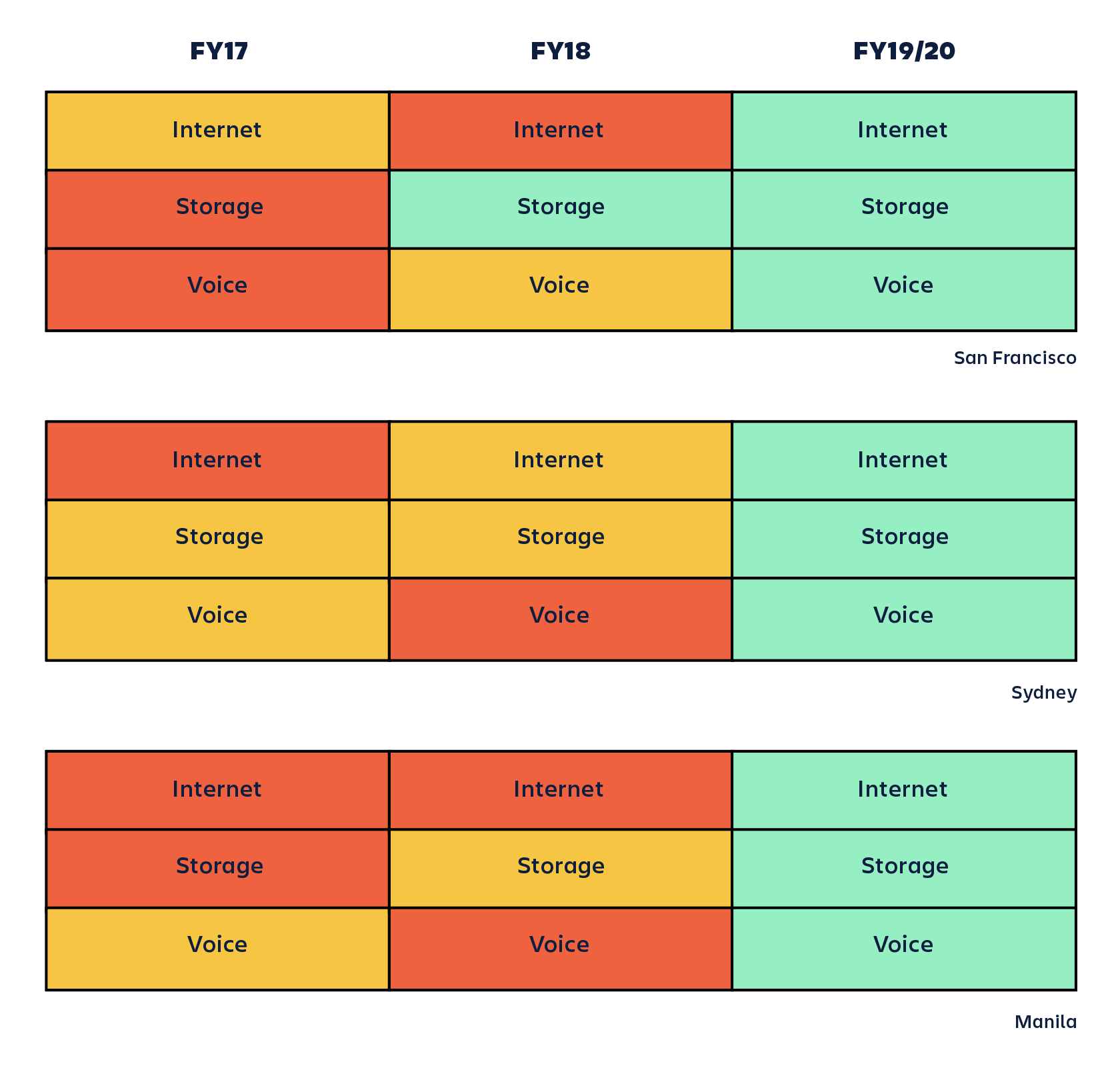Where does your company want to be in one year? Five years? Ten years? And what does this growth mean for your technology stack? These questions play on repeat for any growing organization.
As enterprises grow, often at what feels like a breakneck pace, IT’s job is to support day-to-day tasks while also being the visionaries for successful growth and scale. They are the enablers of technical innovations that result in competitive advantages, and are often under intense pressure to deliver amidst constant and accelerating change. This is no small task.
How do we know? Because we’re going through the same growing pains ourselves.
To learn more about how our IT teams are evolving and what other teams can learn from our mistakes experience, I sat with Ross Chippendale, Atlassian’s Head of Workplace Technology. Ross is responsible for anything IT related that Atlassians use day-in-day-out to get our products to you. He shared three principles that allow us to keep pace and scale confidently as we grow.
Build a rock-solid base for workplace technology
With growth comes challenges, especially with technology. To appropriately handle these challenges you need to start with the basics and understand the core fundamentals of your IT infrastructure: the building blocks. A reliable, secure, and scalable platform on which to build workplace technology systems is critical and should be the first priority.
That’s exactly where Ross and his team began. “Internally we called it ‘get to green’ and mapped the journey in a table on a Confluence page,” he says. “Having a visual makes selling the importance extremely easy when the table is all red, and also particularly satisfying to look back on once it becomes green.”
 Getting to green meant doing a deep dive into what we had, what we needed to maintain and exceed our growth rate (without having to hire an army to build it), and then… doing that. We quickly realized we needed to standardize wherever we could if we were going to create a rock-solid platform for our workplace technology systems.
Getting to green meant doing a deep dive into what we had, what we needed to maintain and exceed our growth rate (without having to hire an army to build it), and then… doing that. We quickly realized we needed to standardize wherever we could if we were going to create a rock-solid platform for our workplace technology systems.
Ross and his team used Confluence to build a status report to guide the process, record changes, and communicate the big picture. In doing so, it enabled them to deal with change, transition, and other “gotchas” that come with growth.
Scaling fast can feel chaotic. So as you embark on your own journey, take a deep breath and remember these four steps:
- Learn from your peers. Reach out to your network and see how other companies are solving the same problems. It’s rare to find a challenge that somebody hasn’t solved.
- Stick to the fundamentals. There is no point in having all the bells and whistles if the system is not running. When selecting a product, always start with the basics and work your way up.
- Never underestimate scale. Think about what you’re building for and multiply it by ten (or more). A great choice for a hundred people is not necessarily right for a thousand.
- To move fast, sometimes you have to slow down. Don’t get caught up in finding solutions before you know what problem you’re trying to solve. Make sure you have a clear picture of your requirements before you activate that trial.
Case in point: our journey with video conferencing
As we burst through our 1,000 employee mark, there was a lot to consider to ensure we were set up for success and stayed ahead of the expectation curve of new employees. We needed to trust our tools from usage to compliance to geographic constraints, after all, these are the tools that we rely on to get s#%t done.
As a global company, video conferencing has always been a key component that is used day in and day out by employees around the globe. But due to rapid growth, we realized it was a free-for-all and staff were using whatever suited them best. This led to a significant support burden from a technical side which impacted our end-user experience. This was not an option if we wanted to scale smart.
To decrease the tech burden and ensure positive experiences, we engaged with staff to map out the user experience from the moment they decided to have a meeting, right through to sending out the minutes. From research and conversations, we focused on addressing the employee’s pain points. Quickly we turned around staff sentiment to the usability of our video conferencing stack by consolidating onto a singular product and decreasing the support burden.
Now employees across the globe have a consistent and positive meeting experience, that we know will scale as we grow, and allow employees to focus on the tasks at hand, not worry about tech issues.
Be proactive, not reactive
As important as having a strong IT foundation is, you still need a plan to stay ahead of your company’s growth. This will allow you to scale with confidence and build a long-term strategy for scaling teams, applications and infrastructure. If you don’t, you run the risk that by the time change is implemented you will be behind the curve and your mission-critical tools will be mission culpable.
We needed to build everything for a larger company than the one in which we were operating. – Ross Chippendale, Head of Workplace Technology
Ross and team faced the task of ensuring our employees could do their best work with as little negative impact as we scaled. In order for them to be proactive, we had to admit to ourselves that we weren’t a start-up anymore. With this change in mindset came a change in approach: considering scalability with each step, from inception to delivery. So they focused on adopting products and tools that would scale with us as we grow – not just products with the most buzz.
Fortunately, shifting your mindset to think “bigger” is both straightforward and effective:
- Think deeply about what you want to achieve with technology. Once you’ve decided, act swiftly, else the need will fall off your radar (for a while).
- Set aside time to keep on top of tech industry trends, and what other industries are doing with technology. If you set a little bit of time aside every day to learn or keep in touch, you won’t be caught off-guard and can make strategic recommendations to your business proactively.
- Always have a plan B and C, especially in vendor negotiations. You never know what may happen as a deal unfolds, and having to go back to square one is not only “no fun,” but will derail any chance of a timely implementation.
Be prepared to fail fast
“Perhaps the only thing more difficult than preparing for growth is reacting to growth at high speed,” Ross is quick to remind us. Turnaround times can dictate the success of an organization. To appropriately respond to growth you need to embrace a culture of experimentation and tolerance for iterative improvement, hence a culture that supports the ability to fail fast and learn.
✅ Use the Atlassian Team Playbook to help embrace a culture of iteration. The End-to-end Demo is a great technique is great for getting feedback early on, while the Retrospective helps you learn and adapt.
“Our single sign-on implementation was very much driven by the fail-fast philosophy,” Ross explains. “We had several false starts, but learned each time, changed course and tested our findings with a new MVE (minimum viable experience) until we were confident enough to go big. And even then, we went big with the platform, but brought on SSO applications gradually.”
Many leaders would raise an eyebrow at this type of iterative approach, fearful that IT might look bad or receive backlash if a less-than-perfect solution is rolled out. This is why transparency and building a culture accepting of iterative approaches is important. Throughout the process, Ross and team solicited feedback from Atlassian staff as they used the platform in early iterations, and kept listening throughout the project as they continued failing fast and falling forward.
Realizing the power of fast iterative releases has shaped our approach to pretty much every other initiative we have taken on and helped our IT team plan, stay ahead, and deal with growth in stride.
Growth for an organization should be exciting, beneficial and celebrated. Through adhering to these principles, utilizing appropriate technology, and building a strong technical foundation, IT teams can face growth head-on and let the rest of the company focus on delivering great products. As has been the case with Atlassian, you may find you can support a growing company with a workplace technology team that sits well below the normal staff-to-support ratio.
. . .
Don’t close this tab yet! Check out our new whitepaper for more tips on running a lean, mean version of ITSM with Atlassian.

